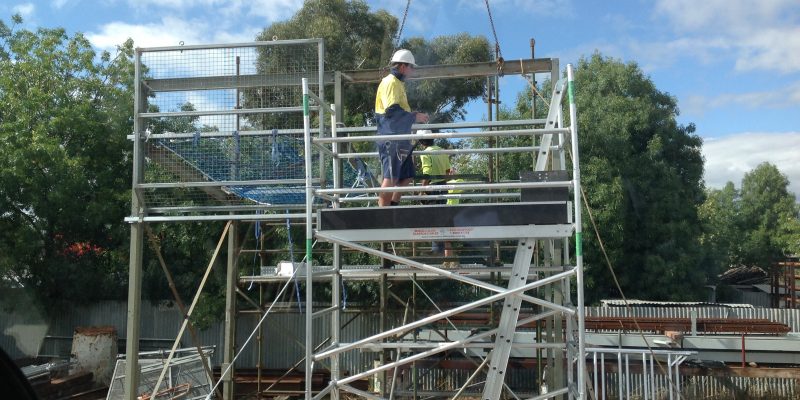Duration: 5 days of training which includes a formative assessment and 1 day of WorkSafe Assessment which includes but not restricted to:
A person who demonstrates competency in this unit must be able to provide evidence of the ability to:
- comply with OHS licensing legislation.
- effectively communicate and work safely with others in the work area.
- effectively conduct risk assessment and management procedures.
- effectively complete the following tasks:-
- inspection of all plant and equipment, and
- installation of a fall arrest system (Static line), and
- use of a safety harness / fall arrest system, and
- installation of crane loading platforms and
- installation of a safety net, and
- installation of a shutter and safety screen, and
- demonstrated ability to work safely at heights, and
- erection of structural steel, and
- erection of precast panel, and
- set up and operation of a winch for load movement, and
- installation of a materials hoist, or
- installation of a mast climber.
- effectively demonstrate the tying of knots,
Assessment: A full WorkCover Assessment
1 Day
A person who demonstrates competency in this unit must be able to provide evidence of the ability to:
- comply with Commonwealth, state or territory OHS legislation, standards relevant to Basic Rigging and crane operations.
Required skills for this unit are:
- ability to calculate Safe Working Load (SWL) and Working Load Limit (WLL)
- ability to erect and dismantle, level, plumb and stabilise associated plant and structures
- ability to work safely at heights including the correct application of safety equipment.
- accurate interpretation of basic structural charts and structural plans (site information)
- applying methods for making temporary connections of ropes using fibre and synthetic types
- apply methods of splicing and whipping fibre and synthetic ropes
- correct application and use of all rigging and associated equipment
- risk assessment and hazard control strategies
- interpersonal and communication skills at a level sufficient to site/workplace requirements. This includes the relevant communication methods and equipment.
- verify problems and equipment faults and demonstrate appropriate response.
Required knowledge for this unit is:
- appropriate mathematical procedures for estimation and measurement of loads
- ability to interpret manufacturer’s specifications for all plant and equipment use in rigging operations
- knowledge of principles relating to all plant, equipment and structural stability
- knowledge of the types and functions of rigging, safety and associated equipment including an understanding of their limitations.
- organisational and workplace standards, requirements, policies and procedures for rigging
- understanding of the hierarchy of hazard identification and control
- relevant Commonwealth, state or territory and local government OHS legislation, standards and codes of practice for undertaking rigging activities
- understanding of inspection and maintenance requirements of a wide range of appropriate plant and equipment in line with Australian Standards or manufacturer’s specifications
- estimation of ground bearing pressures of the full range of soil types and associated ground conditions for setting up plant and equipment.
Course Requirements
- 100 points of identification
- Pens
- Calculator
- Safety Helmet; boots and Hi vis clothing
About Our Course: Our course will allow you to achieve a Certificate in Basic Rigging, which incorporates all applicable certification requirements.
All classes are conducted in English and students should have a sound knowledge of the English language. You will be assessed with both a Theory Exam: Calculation and a Practical Test.

